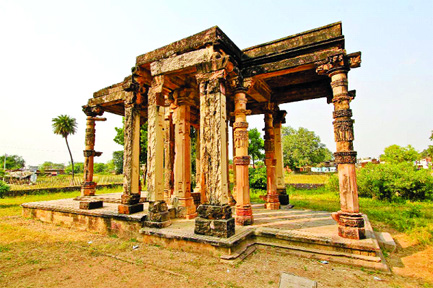Khajuraho, a UNESCO World Heritage Site located in Madhya Pradesh, is known around the world for its stunning temples adorned by erotic and sensuous carvings. A small town located in the Bundelkhand region, Khajuraho is a brilliant example of Indian architecture and its culture back in the medieval period. The architecture of these Hindu and Jain temples depict the erotic forms of love, the carvings on the walls display passion in the most sensuous yet aesthetic ways. Built between 950 to 1050 AD the sheer confrontational nature of these carvings shows a stark paradox with the conventional Indian ideals about eroticism, leaving everybody spellbound.
Art in this small town is engrained in all of its structures and are a classic example of the finesse of India‘s cultural and artistic heritage. The best part about Khajuraho is that although scores of plunderers tried to destroy the whole complex, they could never succeed, even though they managed to reduce the number of temples and caves to 25 from a staggering 85 at the time it was created.
Dulhadev Temple
Built in the year 1130 the Dulhadev Temple enshrines a beautiful shivalingam and striking sculptures of Apsaras and other ornamented figures. The temple also has a stunning sculpture of Lord Shiva with his wife Parvati, the intricate details of the carvings adding to the charm of the overall architecture.
Kandariya Mahadev Temple
Built around 1025-1050 AD, this temple exudes grandeur and finesse in its architecture. With beautiful frescos of women in various postures adorning the walls of this temple, this place is one of the most stunning tourists sites in Khajuraho.
Kandariya Mahadev Temple has an artistically engraved shrine with over 800 images of women, most of which are more than 3 feet high. The temple is dedicated to Lord Shiva and has a shivalingam at the centre of Garba Griha. Made of a typical sandstone structure, the artisitic representation of eroticism on the walls of this temple are bound to give a new perspective on India’s cultural heritage.
Lakshman Temple
The oldest and most aesthetically pleasing temples among the Western group of Temples, the Lakshman temple is named after the ruler of that time. The trinity of Brahma, Vishnu and Shiva is depicted in the horizontal beam over the entrance of the temple.
Parsvanath temple
This temple is the largest among the Eastern group of temples and has intricately detailed carvings on its walls. The most intriguing side of the architecture of this temple is the aesthetic blend of Hindu, muslim and Buddhist styles.
The highlights of the temple are the sculptures on the northern outer walls.
Vishwanath Temple
Dedicated to Lord Shiva, this temple is one among the western group of temples. It has a beautiful marble shivalinga as the main deity. An imposing image of Brahma is also housed in this temple. A massive sculpture of Nandi the Bull is also enshrined alongside the Shivalingam.
HOW TO REACH KHAJURAHO?
By Train: Khajuraho railway station is five km away from the main town and is linked to a few cities of Madhya Pradesh. Mahoba is the closest major railhead from Khajuraho which is around 78 km away. Trains from Mathura, Varanasi, Mumbai, Kolkata, Allahabad, Jabalpur, Gwalior, etc. run regularly from Mahoba.
By Air: Khajuraho has its own domestic airport at a distance of two km from the temple sites. It has flights connected to Delhi, Mumbai, Bhopal, Varanasi etc. You can hire local cabs to reach the nearest hotel or the temple.
By Road: With a decent transport network, roads to Khajuraho are well linked to all the major National and State Highways. From Khajuraho, many public and private buses travel to nearby cities like Jhansi. Standard buses, non AC and AC buses run regularly. Also, you have the option to hire private cabs to reach your destination.
Khajuraho: The Architectural Masterpiece
